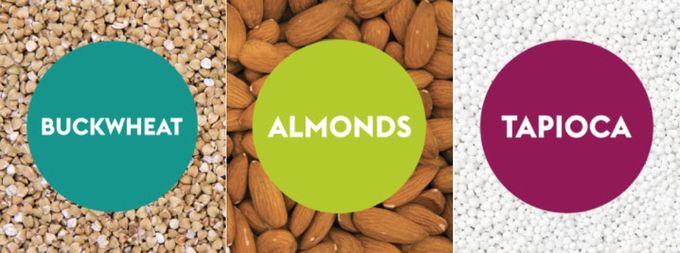All You Need to Know About Toddler Nutrition and Formulas Designed for Toddlers
Find out how toddler formulas can support your child's growth and development better than whole cow's milk
Published June 26, 2024

As toddlers transition from infancy, their nutritional choices become more diverse and complex. Here's all you need to know about the advantages of toddler formulas and how they can provide superior nutritional support compared to whole cow's milk—this information will help you make informed decisions about supporting your child's growth and development during this critical stage.
» Discover delicious, plant-based nutritional formulas your toddler will love
Transitioning From Infancy to Toddler Formulas
In the first year, the nutritional choices are straightforward—breast milk is preferred, and infant formula is the next best option. The FDA clearly defines the regulatory requirements for infant formula nutrient content.
» Here's how to easily transition your baby from breastmilk to formula
However, the landscape changes as a child transitions to the toddler years (12-36 months). The nutrient content regulations for toddler formulas are not as well-defined. Yet, manufacturers must still adhere to current FDA good manufacturing practices and ensure accurate labeling and nutrient content throughout the shelf life.
» Explore the best dairy-free toddler formulas
Most toddler formulas are powdered products that mix easily with water to provide a nutrient-rich drink. While there are various formulation choices, many contain proteins or ingredients from cow's milk or soy. Families seeking to avoid dairy or soy have limited options in today's market.
Shifting Consumer Preferences and Demand for Alternatives in the US
Dairy consumption in the US has declined significantly over the years, with the average person consuming 149 pounds of milk in 2018 compared to 247 pounds in 1975—a 60% decrease. Consumers are increasingly gravitating towards full-fat dairy, organic milk, and non-dairy "milks" like almond and coconut, which, in fact, lack the essential nutrients required for child development.
» Here's how to choose dairy-free formula for your little one
This shift in consumer preferences, coupled with growing awareness of dairy allergies and intolerances, has led to a demand for alternative, plant-based nutritional options for children. Recognizing this rising trend, we developed a balanced, nutritious, plant-based, dairy-free, and soy-free formula alternative for toddlers aged 12-36 months.
» Discover the signs showing your kid is lactose intolerant
Else Nutrition's Plant-Based Toddler Formula Alternative
Else Nutrition has developed a novel, patented plant-based formula alternative for toddlers aged 12-36 months. This nutrient-rich formula derives its protein from a proprietary blend of almonds and buckwheat, using a clean, chemical-free process.
» Find out why plant-based toddler nutrition is so healthy
The three core ingredients—almond, buckwheat, and tapioca—make up approximately 92% of the formulation. This 100% plant-based alternative is free of dairy, soy, antibiotics, hormones, gluten, and genetically modified ingredients. The powder formula mixes easily with water to provide a nutritious drink for toddlers.
» Explore a healthier, omega plant-based alternative for your toddler
3 Key Organic Ingredients in Else Toddler Nutrition
1. Organic Buckwheat
Buckwheat, or common buckwheat (Fagopyrum esculentum Moench), is a plant cultivated for its grain-like seeds. It is considered a pseudocereal because it is typically used in a manner similar to cereals.
Buckwheat, despite its reference to “wheat,” is not a grass and is not taxonomically related to wheat. It is more commonly related to sorrel, knotweed, and rhubarb.
» Get expert insights on plant-based formula for babies
Buckwheat is a nutritious grain with the following key features:
- Protein content: Approximately 10.6 g per 100 g dry weight, with high levels of essential amino acids like leucine (6.9 g/100 g) and lysine (5.84 g/100 g).
- Buckwheat flour composition: Buckwheat flour contains ~13.25 g of protein per 100 g and is a good source of potassium 460 mg/100 g and iron 2.4 mg/100 g.
- Carbohydrate processing: The buckwheat flour used in the formula contains ~74% carbohydrate. The composition of the carbohydrate is ~25% amylose and 75% amylopectin.
» Understand your child's carbohydrate needs
The buckwheat flour in Else formula is treated with alpha-amylase to digest some of the complex carbohydrates into smaller pieces, such as maltose and dextrins, to facilitate digestion in young children. Total sugar after amylase treatment is only 10% of the total carbohydrate. The alpha-amylase used in the manufacture of the toddler formula breaks down the carbohydrate into smaller pieces.
» Discover the whole Foods difference behind Else Nutrition
Buckwheat is low in fat (3.4 g/100 g) but rich in dietary fiber, polyphenols, antioxidants, and trace minerals like zinc, copper, and manganese. It also has prebiotic properties. Buckwheat does not contain gluten proteins and may be used by those with celiac disease.
2. Organic Almond Butter
California almonds (Prunus dulcis) are blanched to soften the seed coat, which is then removed and ground into a paste or butter and used in the Else formula. Removing the seed coat reduces the phytic acid content to facilitate the absorption of iron and zinc. Almond butter is gluten-free.
The ground almond contains:
- ~28% protein
- 13% carbohydrate (starch)
- 50% fat
» Here's all you need to know about almonds
Almond butter is a rich source of oil (>50% of the almond by weight), with the majority (32%) of the fatty acids as monounsaturated fatty acids and oleic acid (18:1n9). Other fatty acids in almond butter include 13% linoleic acid (18:2n6) and 10% saturated fatty acids, such as palmitic acid (16:0).
Almond protein is highly digestible, and the fiber content has been shown to function as a prebiotic, altering the intestinal microbiota to a favorable profile.
» Understand if vegan formula is safe for babies
3. Organic Tapioca
Tapioca is commonly used in many foods because of its carbohydrate content and ability to deliver the appropriate viscosity or thickness in a formula. The tapioca used in Else Toddler Nutrition mixes readily with water to provide the appropriate consistency for the formula.
» Find out what to look for and what to avoid in formula ingredients
Could a Child be Allergic to Buckwheat and Almonds?
While any food protein can theoretically cause an allergy, some are more common allergens, especially for young children. These include cow's milk, eggs, wheat, soy, peanuts, tree nuts (like almonds), fish, and seafood.
» Find out more about soy allergy symptoms in kids
Almond, a tree nut, contains proteins that may trigger allergic reactions in sensitive individuals. Similarly, though rare, buckwheat has been reported to cause immediate allergic responses in some people.
The prevalence of buckwheat allergy is not well-documented due to limited research. However, if you suspect an allergy to any of the ingredients in Else's formulas, such as buckwheat or almond, do not use this product.
» Read more about food allergies in babies
Are toddler formulas recommended by experts?
If the diet of the toddler is well-rounded and meets typical nutrient requirements anticipated from conventional foods (meats, eggs, dairy, plant proteins, fruits, nuts, and vegetables), and anthropometric growth is normal, then additional nutrition in the form of a toddler formula is not a necessity.
However, experts may recommend nutrient-rich toddler formulas or up-age formulas when there is a recognized need for additional nutrients that may be lacking in the toddler's diet.
WCM sold in the United States, has relatively high protein and saturated fat content than is needed for most toddlers. WCM has very little of the dietary essential fatty acid, linoleic acid relative to CODEX standards, expert recommendations and toddler formulas in the market. There is no DHA or AA in cow’s milk. Whole cow’s milk is lacking in many vitamins (E, K, C, and riboflavin and is also deficient in the essential trace mineral iron.
Else toddler formula alternative meets or exceeds the minimum recommendations of the CODEX International Food Standards for follow-up formula originally adopted in 1987 and as amended in subsequent years. In addition, Else toddler formula is within the range of nutrients identified for the European Market for young children between the ages of 1 and 3.
Toddler Formula Nutrient Profile
Protein
The US toddler formulas have conventional protein sources such as cow’s milk (nonfat or reduced fat (skim) cow’s milk) or a blend of nonfat cow’s milk and whey protein concentrate.
The soy protein isolate used in the US formulas is supplemented with the amino acid L-methionine to support the amino acid profile of the soy protein.
The protein in the Else toddler formula alternative is provided by the almond and buckwheat ingredients and provides an amino acid profile that does not need to be fortified with amino acids.
Carbohydrate
Regarding carbohydrate sources, most formulas use extracts derived from corn (corn syrup solids or corn maltodextrin) and lactose (cow’s milk derived). Some formulas add a prebiotic fiber, galactooligosaccharides (GOS) or fructooligosaccharides (FOS), to support gut health.
The carbohydrate in Else toddler formula alternative is provided by tapioca and buckwheat flour. Else nutritious toddler formula provides a natural source of fibers from almond paste and buckwheat flour to support gut health.
Fat
The oil blends of the formulas are diverse; however, all of the formulas use soy, high oleic (HO)-safflower/sunflower oil to provide oleic acid (18:1n9) and support essential fatty acid intakes of linoleic acid (18:2n6) and linolenic acid (18:3n3) and coconut oil (for a source of saturated fat).
HO-sunflower or HO-safflower oil is used in many of the formulas to provide oleic acid (18:1n9). Palm olein oil is added to some toddler formulas to provide palmitic acid (16:0).
Else toddler formula is unique in this product comparison as the fat is derived primarily from the almond paste and only a small amount from the buckwheat flour. Importantly, the essential fatty acid, linoleic acid (18:2n6), is not compromised in the Else formulation as it compares favorably to the other formulas.
Vitamins and Minerals
The toddler formulas are similar to each other in terms of vitamin and mineral content. The differences between formulas are relatively insignificant from a nutritional perspective.
Toddler Formulas for Optimal Nutrition
Toddler formulas are an excellent choice for supporting the nutritional needs of children aged 1-3. These specialized formulas are superior to whole cow's milk in providing essential vitamins, minerals (particularly iron), and other key nutrients and micronutrients (without excessive amounts of protein or saturated fat) that toddlers need for their growth and development.
By feeding your toddler formulas, you can help ensure your kiddo receives a balanced and complete nutritional intake to support their rapid physical and cognitive growth during this critical stage of development.
Else plant-based toddler formula is an excellent choice for families looking for a healthy nutritional option without cow’s milk ingredients or soy ingredients.
The content and advice provided in this article are for informational purposes only and are not a substitute for medical diagnosis, treatment, or advice for specific medical conditions. Always consult a pediatrician to understand the individual needs of your child.














